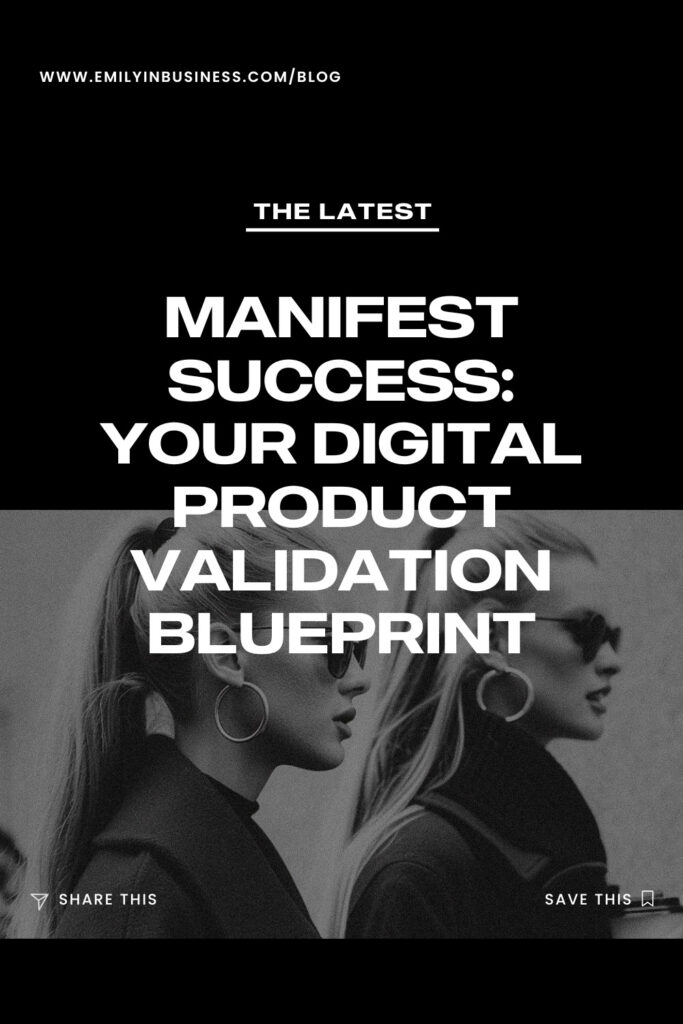Manifest Success: Your Digital Product Validation Blueprint
Jan 17
This post may contain affiliate links, which means I’ll receive a commission if you purchase through my links, at no extra cost to you. Please read the full disclosure for more information.
Ever had that late-night idea you were convinced would change the world, only to realise weeks of development later that no one actually wanted it? I’ve been there. Launching a digital product empire without validation is like cooking food without tasting it… you might get lucky, but you’re probably setting yourself up for disappointment.
The truth about digital product validation is refreshingly simple: you don’t need a perfect product to start, you need perfect understanding of your market’s needs. For additional inspiration on digital products, we have outlined the best ideas. After spending years helping entrepreneurs and watching countless product launches (some soaring, others flopping), I’ve learned that validation isn’t just another box to check – it’s your map through the unpredictable terrain of product development.
Think of product validation like dating – you wouldn’t propose marriage on the first date, right? Instead, you test compatibility through conversations, shared experiences, and gradually increasing commitment. The same approach works for products. Start with simple conversations, test basic concepts, and let your audience guide your development before investing significant time and resources.
This isn’t just theory – I’ve watched solopreneurs save months of wasted effort and startups preserve crucial runway by validating early and often. One of my clients actually discovered their “backup” feature was more valuable than their main product, but only because they took the time to validate before fully building either.
The digital landscape in 2025 moves too fast for the “build it and they will come” approach. Whether you’re crafting your first digital product or your fifteenth, knowing how to validate effectively isn’t just helpful – it’s essential for survival and success in today’s market.
Remember: The goal of validation isn’t to prove your idea is perfect – it’s to learn exactly what your market needs, and how your product can serve that need. Let’s explore how to do that effectively.

Next project needs validation? Save this Post!
Understanding Digital Product Validation
When I first started building digital products, I made what I now call the “perfect product trap” mistake – spending six months coding a feature-rich platform before showing it to a single potential customer. The market’s response? Crickets. That expensive lesson taught me why validation isn’t just important – it’s absolutely critical for survival in today’s digital economy.
What is Digital Product Validation?
Digital product validation is the process of testing your product idea against real market demand before investing heavily in development. Unlike traditional market research, which might rely on focus groups and surveys, digital validation is more dynamic and interactive. You’re not just asking people if they’d hypothetically buy your product – you’re getting them to take concrete actions that prove their interest.
I’ve found that effective validation often looks more like a conversation than a research project. It’s about building relationships with potential users, understanding their daily challenges, and testing solutions in real-time. The beauty of digital validation is that you can gather meaningful data quickly and adjust your approach based on actual user behavior, not just their stated preferences.
Key Components of Effective Validation
The foundation of validation starts with really understanding market demand. This means going beyond just identifying a problem – you need to verify that people are actively seeking (and willing to pay for) a solution. Through my work with various startups, I’ve seen that the most successful validation efforts focus on finding specific pain points that people are already trying to solve, even if their current solutions are imperfect.
Your MVP shouldn’t try to be everything to everyone. Start with the absolute minimum feature set that solves one specific, burning problem. I recently helped a client pare down their initial product idea from fifteen features to just two – and those two features ended up generating more interest than the full suite would have.
The Cost of Skipping Validation
Let me share a cautionary tale: I once worked with a startup that spent $300,000 developing a comprehensive project management tool, only to discover their target market was already satisfied with existing solutions. The entire investment could have been saved with just a few weeks of proper validation.
The real cost of skipping validation isn’t just financial – it’s the opportunity cost of time spent building the wrong thing. I’ve seen entrepreneurs spend months perfecting features that users didn’t need, while missing critical functionality that could have made their product successful. One team I advised had to completely pivot their business model after discovering their assumed price point was 3x higher than what their market would bear.
Digital markets move quickly, and the cost of being wrong has never been higher. But here’s the good news: validation doesn’t have to be complex or expensive. Simple landing pages, social media polls, and direct conversations with potential users can provide invaluable insights before you invest significant resources in development.
The key is to start small, test thoroughly, and be willing to adapt based on what you learn. Remember: every successful digital product you see today likely went through multiple iterations of validation and refinement before finding its market fit.
Strategic Validation Frameworks
I started my product journey thinking customer feedback meant asking friends what they thought of my idea. $20,000 in wasted development costs later, I learned that real validation requires a systematic approach. Let me share what actually works in today’s digital landscape.
Market Research Techniques
Online research has evolved way beyond simple Google searches. These days, effective market research combines multiple data points to build a clear picture. I’ve found that running targeted polls on LinkedIn while simultaneously analyzing Twitter conversations gives you both quantitative data and qualitative insights that one method alone can’t provide.
The key is knowing where to look and what to measure. Instead of just checking search volumes, dive into the actual conversations happening in Reddit threads or industry forums. I once discovered that my target market used completely different terminology than I did – this insight alone saved me from making major messaging mistakes.
Tools like Google Trends have become more sophisticated too. Don’t just look at basic trend lines – cross-reference them with seasonal patterns and regional variations. I’ve helped clients identify untapped market opportunities just by analyzing how search patterns differ across different locations and times.
Customer Development Approach
Getting good data from customer interviews is an art. It’s not about asking people if they like your idea – that usually leads to polite nods and useless feedback. Instead, focus on understanding their current behaviors and pain points. I learned to start interviews with “Tell me about the last time you encountered this problem” rather than explaining my solution.
Building customer personas isn’t just about demographics anymore. You need to understand digital behaviors, tool preferences, and workflow patterns. One of my most successful projects came from realizing that our target users weren’t who we thought they were – they were actually the assistants to our intended audience.
Feedback collection needs structure. Create a simple system to organize insights – I use a basic spreadsheet with columns for pain points, current solutions, and desired outcomes. This helps spot patterns that might not be obvious in individual conversations.
Prototype and MVP Development
You don’t need fancy tools to create effective prototypes. I’ve validated ideas using everything from simple Figma mockups to Google Forms disguised as products. The goal isn’t perfection – it’s learning what matters to your users.
Quick validation techniques I’ve found effective:
- Creating a simple landing page with an email signup
- Using no-code tools to build functional prototypes in days, not months
- Setting up fake “Buy Now” buttons to test pricing sensitivity
- Running limited-time “beta access” campaigns to gauge interest
The key is to validate one assumption at a time. Don’t try to test pricing, features, and market fit all at once. I’ve seen teams get overwhelmed by trying to validate everything simultaneously – instead, create a simple hypothesis for each test and tackle them one by one.
Remember, prototyping is about speed and learning, not perfection. Every extra hour spent polishing a prototype is an hour you could have spent gathering real user feedback. Start simple, iterate based on feedback, and only add complexity when you have clear evidence that it’s needed.
Validation Channels and Methodologies
Building digital products without proper validation is like trying to solve a puzzle in the dark. After spending thousands on a failed app launch, I learned that choosing the right validation channels can make all the difference. Here’s what actually works in today’s market.
Digital Validation Platforms
Finding the right platform to validate your idea doesn’t have to be complicated or expensive. I’ve successfully tested products using simple tools like Typeform for surveys and Carrd for landing pages. The trick isn’t having the fanciest tools – it’s using basic ones creatively.
ProductHunt and BetaList have evolved beyond just launch platforms – they’re now great for early validation. I’ve seen startups gather hundreds of potential users before writing a single line of code. Just remember to focus on engagement metrics over raw signup numbers. A hundred engaged potential users are worth more than a thousand casual email submissions.
A word of caution about paid validation tools: while platforms like UserTesting and Validately are powerful, you can often get similar insights using free alternatives. I’ve gotten amazing feedback using simple Reddit posts and Facebook groups, especially in the early stages.
Pre-Sale and Landing Page Validation
Landing pages are your digital truth serum. They tell you if people will actually pull out their credit cards, not just say they like your idea. The key is making your offer concrete enough to test but simple enough to pivot based on feedback.
Start with a basic landing page that focuses on one core problem and solution. I learned this after my first landing page tried to solve five problems at once and ended up solving none. Test different value propositions using tools like Google Optimize – you’ll be surprised how often your assumptions about what people want are wrong.
Running small ad campaigns ($50-100) on platforms like Facebook or LinkedIn can quickly show if people are interested enough to click. Pay attention to click-through rates and bounce rates – they often tell you more than direct feedback ever will.
Community and Network Validation
Online communities have become goldmines for product validation, but only if you approach them right. Don’t just drop in and ask for feedback… the reception might not be well received, make sure you become a genuine member first. I spend at least two weeks actively participating in a community before asking for input on a product idea.
Building a validation network is crucial. Find 10-15 people who fit your target market and are willing to give honest feedback. These early advisors are invaluable… they’ll tell you what others might think but won’t say. I still talk to my first validation group from three years ago.
Remember that not all feedback is equal. When an industry expert points out a potential issue, it’s worth paying attention. But don’t let any single source of feedback completely derail your vision. Look for patterns across different feedback channels before making major changes.
The most valuable validation often comes from unexpected places. Stay open to feedback, but filter it through the lens of your product’s core purpose. Not every suggestion needs to be implemented, but every piece of feedback deserves consideration.
Advanced Validation Metrics and Analysis
Tracking the right metrics changed everything in my validation process. After wasting months focused on vanity metrics like page views, I discovered that understanding the right numbers – and what they actually mean – makes the difference between successful validation and expensive guesswork.
Quantitative Validation Metrics
Think of validation metrics like vital signs for your product idea. You wouldn’t judge your health just by your temperature, and you can’t judge product viability by just one number. I track what I call the “validation vital signs” – conversion rate, cost per engaged user, and what I call the “stick rate” (how long users actually keep engaging).
For example, when testing a new product idea, I look for:
- Conversion rates above 2% on cold traffic
- Customer acquisition costs under 1/3 of your planned price point
- At least 40% of test users returning within the first week
These numbers aren’t just statistics – they’re early warning signals. I once caught a major product issue when our second-week engagement dropped by 30%, long before users started complaining.
Qualitative Feedback Interpretation
Numbers tell you what’s happening, but user feedback tells you why. The trick is learning to read between the lines. When users say “It’s interesting,” that usually means they’ll never use it. But when they ask “Can it also do X?” – that’s gold. They’re already imagining using your product.
I organize feedback into three buckets:
- Must-have features (users mention without prompting)
- Nice-to-have features (mentioned when asked)
- Problem indicators (hesitations or concerns)
This system helped me identify a critical feature gap in my last product before launch, saving months of post-launch scrambling.
Continuous Validation Process
The market doesn’t stand still, and neither should your validation. Set up ongoing monitoring systems – I use a mix of automated tools and regular check-ins with early users. One of my most successful clients spotted a market shift two months before their competitors because they kept validating even after launch.
Build feedback loops into your product development cycle. Schedule regular validation check-ins – I do mine monthly – to ensure you’re still solving the right problems. Markets evolve quickly, and yesterday’s perfect solution might not match today’s needs.
Remember, validation isn’t a one-time event – it’s a continuous process. Keep testing assumptions, gathering feedback, and adjusting course. The most successful products I’ve worked with are those that never stop validating and evolving with their market.
Conclusion
Building digital products is a bit like being a chef – even the best recipe needs tasting and adjusting before serving it to customers. Through my journey helping entrepreneurs and launching my own products, I’ve learned that validation isn’t just about preventing failure – it’s about building confidence in your direction.
Think of all the validation techniques we’ve covered as your product development GPS. Just like you wouldn’t start a cross-country road trip without checking your route, you shouldn’t build a product without validating your path. The best part? Every validation step makes your product stronger and your vision clearer.
I’ve seen firsthand how proper validation can turn a good idea into a great product. One of my favorite success stories is a client who discovered through validation that their target market was actually willing to pay three times more than planned – but for a slightly different feature set than originally envisioned. Without validation, they would have left serious money on the table.
Here’s what I want you to remember: validation isn’t about proving yourself right – it’s about learning what’s right for your market. Every piece of feedback, every test result, every user interaction brings you closer to building something people will actually love and use.
Don’t let another great idea get stuck in the “what if” phase.
Start your validation journey today! Even if it’s just creating a simple landing page or talking to potential users. The insights you gain now will save you countless hours and resources down the road.
Remember: the most successful digital products aren’t always the ones with the best initial ideas… they’re the ones that were shaped and refined through careful validation. Your next great product is waiting to be discovered through the validation process. Take that first step today.
BEST OF THE MANUAL
Can I let you in on something that’s been driving me crazy? I’ve watched countless bloggers exhaust themselves in the create-publish-repeat cycle, churning out new content week after week, only to see their SEO results stay frustratingly flat. Meanwhile, the bloggers who figured out this one secret are quietly dominating search rankings with half the […]







+ Show / Hide Comments
Share to: